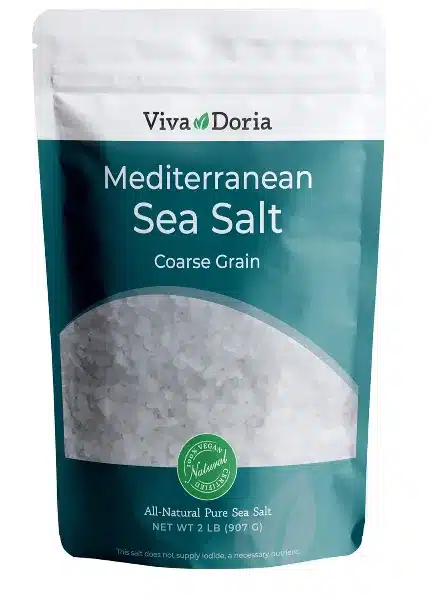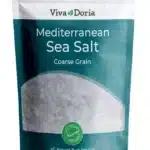When deciding between Mediterranean Sea Salt and Celtic Sea Salt, consider their mineral content. Mediterranean Sea Salt has more potassium, magnesium, and calcium, while Celtic Sea Salt offers iron, zinc, and manganese. Both salts enrich flavors and provide nutrition. Mediterranean Sea Salt has a briny taste with earthy hints, perfect for finishing dishes, while Celtic Sea Salt adds a delicate sweetness to meats and stews. Each salt’s unique harvesting methods contribute to its distinct flavor. Choose the salt that enhances your meals best.
Mineral Composition
When comparing Mediterranean Sea Salt to Celtic Sea Salt, you’ll notice a difference in their mineral compositions. Mediterranean Sea Salt is known for its higher mineral content compared to Celtic Sea Salt. This salt is harvested from the Mediterranean Sea and retains essential minerals like potassium, magnesium, and calcium. These minerals not only enhance the flavor of the salt but also provide added nutritional benefits.
On the other hand, Celtic Sea Salt, harvested from the coastal regions of Brittany, France, has a slightly lower mineral content than Mediterranean Sea Salt. However, it still contains a rich array of minerals such as iron, zinc, and manganese. The unique mineral composition of Celtic Sea Salt gives it a distinct taste that many chefs appreciate.
Flavor Profiles
Comparing the mineral compositions of Mediterranean Sea Salt and Celtic Sea Salt provides insight into their distinct flavor profiles.
Mediterranean Sea Salt, rich in minerals like magnesium and calcium, offers a well-rounded flavor with a slightly briny taste and hints of earthiness. This salt is often described as having a clean and bright flavor that enhances the natural taste of foods without overpowering them.
On the other hand, Celtic Sea Salt, harvested through evaporation using traditional methods, contains minerals like potassium and trace elements that contribute to its unique flavor profile. Known for its subtle complexity, Celtic Sea Salt has a milder taste compared to Mediterranean Sea Salt, with delicate salty notes and a slightly sweet finish.
When choosing between these two salts, consider the flavor profile that best complements your dishes, whether you prefer the robust taste of Mediterranean Sea Salt or the nuanced flavors of Celtic Sea Salt.
Harvesting Methods
Harvesting methods for Mediterranean Sea Salt and Celtic Sea Salt differ significantly in their approach and techniques. When it comes to Celtic sea salt, the process involves a more traditional and manual approach compared to Mediterranean sea salt.
- Celtic Sea Salt Harvesting Methods:
- Hand harvesting: Celtic sea salt is typically hand-harvested using wooden tools like rakes. This method allows for a more artisanal and careful collection process.
- Solar evaporation: After being collected, the saltwater is evaporated using the sun’s heat, leaving behind the salt crystals. This natural evaporation process contributes to the salt’s unique flavor profile.
- Mineral-rich clay: Some Celtic sea salt producers line their salt ponds with mineral-rich clay. This clay adds additional nutrients and minerals to the salt during the harvesting process.
These methods highlight the meticulous care and attention to detail involved in harvesting Celtic sea salt, resulting in a product that isn’t only flavorful but also rich in essential minerals.
Culinary Uses
Exploring the diverse culinary applications of Mediterranean Sea Salt and Celtic Sea Salt reveals their distinct flavor profiles and versatile uses in cooking. Mediterranean sea salt, known for its bright, briny taste, is excellent for finishing dishes like salads, grilled vegetables, and seafood. Its large, flaky texture adds a satisfying crunch and a burst of saltiness.
On the other hand, Celtic sea salt, with its mineral-rich taste and slightly moist texture, is great for seasoning meat, soups, and stews during cooking. It dissolves easily, evenly distributing its savory essence throughout the dish. Both sea salts can be used in baking to enhance the flavors of bread, cookies, and pastries.
When preparing a dish that requires a delicate touch, such as a fresh salad or a light soup, opt for Mediterranean sea salt to elevate the natural flavors. For heartier fare like roasted meats or robust stews, Celtic sea salt’s robust taste will deepen the overall savory profile. Experimenting with these two distinct sea salts in your recipes will add depth and complexity to your culinary creations.
Health Benefits
Enhancing your well-being, both Mediterranean Sea Salt and Celtic Sea Salt offer unique health benefits that can complement your dietary choices. When it comes to health benefits, here’s what you can expect:
- Rich in Minerals: Both Mediterranean and Celtic sea salts contain essential minerals like magnesium, calcium, and potassium, which are beneficial for various bodily functions.
- Balanced Electrolytes: These sea salts help maintain proper electrolyte balance in your body, supporting hydration and muscle function.
- Lower Sodium Content: Compared to regular table salt, Mediterranean and Celtic sea salts are slightly lower in sodium content, which can be advantageous for individuals looking to reduce their sodium intake.
Incorporating these sea salts into your diet not only enhances the flavor of your dishes but also provides you with these health benefits. Whether you choose Mediterranean Sea Salt or Celtic Sea Salt, both options can be a flavorful and health-conscious addition to your meals.
Environmental Impact
Considering the environmental impact of Mediterranean Sea Salt and Celtic Sea Salt in their production and extraction processes reveals significant differences in sustainability practices.
Mediterranean Sea Salt is harvested from the Mediterranean Sea, a practice that has sparked concerns about marine ecosystem disruption. The extraction of salt from this sea can potentially affect the delicate balance of marine life, leading to habitat degradation and water pollution.
On the other hand, Celtic Sea Salt, harvested off the coasts of Brittany, France, follows more environmentally friendly practices. The Celtic Sea Salt Company prides itself on sustainable harvesting methods that prioritize ecosystem preservation. By hand-harvesting salt from the Celtic Sea using traditional techniques, this company minimizes its ecological footprint and ensures the long-term health of the marine environment.
Choosing Celtic Sea Salt over Mediterranean Sea Salt can be a more environmentally conscious decision due to its commitment to sustainable practices and the protection of marine ecosystems.
Frequently Asked Questions (FAQ)
What are the different types of salt available?
Salt comes in various forms, including table salt, sea salts such as Celtic sea salt and Mediterranean sea salt, Himalayan salt, and kosher salt. Each type has its unique characteristics and uses.
How is salt harvested?
Salt is harvested through processes like evaporation of seawater or extraction from salt mines. The method of harvesting can impact the mineral content and flavor of the salt.
What is the difference between table salt and sea salt?
Table salt is typically refined and processed to remove impurities, while sea salt like Celtic sea salt and Mediterranean sea salt is often unrefined, retaining trace minerals and a different flavor profile.
What are the benefits of using Himalayan salt?
Himalayan salt is prized for its mineral content, which includes chloride, magnesium, potassium, and other trace minerals. It is believed to have health benefits and a unique taste.
Can salt crystals be used as finishing salt?
Salt crystals can indeed be used as finishing salt to add texture and a burst of flavor to dishes. They are often larger in size compared to regular salt grains.
Is there a difference between Celtic sea salt and regular table salt?
Celtic sea salt is typically unrefined and retains minerals and elements that are usually stripped away during the processing of table salt. This difference can affect both taste and nutritional value.
What is the role of sodium chloride in salt?
Sodium chloride is the chemical compound that makes up most of the salt we consume. It is essential for various






